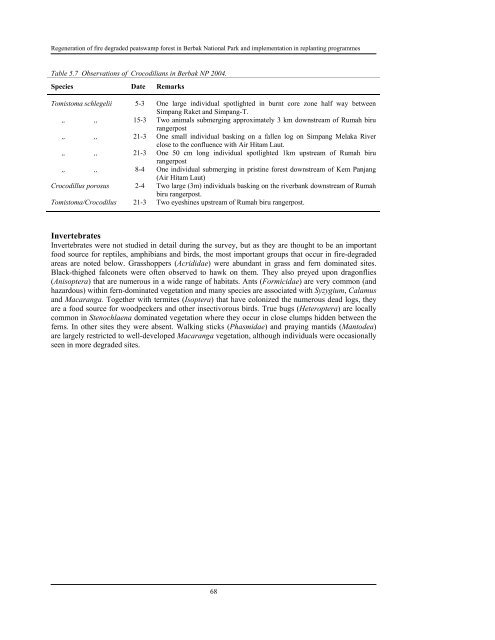Regeneration of fire degraded peatswamp forest in Berbak National ...
Regeneration of fire degraded peatswamp forest in Berbak National ...
Regeneration of fire degraded peatswamp forest in Berbak National ...
Create successful ePaper yourself
Turn your PDF publications into a flip-book with our unique Google optimized e-Paper software.
<strong>Regeneration</strong> <strong>of</strong> <strong>fire</strong> <strong>degraded</strong> <strong>peatswamp</strong> <strong>forest</strong> <strong>in</strong> <strong>Berbak</strong> <strong>National</strong> Park and implementation <strong>in</strong> replant<strong>in</strong>g programmes<br />
Table 5.7 Observations <strong>of</strong> Crocodilians <strong>in</strong> <strong>Berbak</strong> NP 2004.<br />
Species Date Remarks<br />
Tomistoma schlegelii 5-3 One large <strong>in</strong>dividual spotlighted <strong>in</strong> burnt core zone half way between<br />
Simpang Raket and Simpang-T.<br />
,, ,, 15-3 Two animals submerg<strong>in</strong>g approximately 3 km downstream <strong>of</strong> Rumah biru<br />
rangerpost<br />
,, ,, 21-3 One small <strong>in</strong>dividual bask<strong>in</strong>g on a fallen log on Simpang Melaka River<br />
close to the confluence with Air Hitam Laut.<br />
,, ,, 21-3 One 50 cm long <strong>in</strong>dividual spotlighted 1km upstream <strong>of</strong> Rumah biru<br />
rangerpost<br />
,, ,, 8-4 One <strong>in</strong>dividual submerg<strong>in</strong>g <strong>in</strong> prist<strong>in</strong>e <strong>forest</strong> downstream <strong>of</strong> Kem Panjang<br />
(Air Hitam Laut)<br />
Crocodillus porosus 2-4 Two large (3m) <strong>in</strong>dividuals bask<strong>in</strong>g on the riverbank downstream <strong>of</strong> Rumah<br />
biru rangerpost.<br />
Tomistoma/Crocodilus 21-3 Two eyesh<strong>in</strong>es upstream <strong>of</strong> Rumah biru rangerpost.<br />
Invertebrates<br />
Invertebrates were not studied <strong>in</strong> detail dur<strong>in</strong>g the survey, but as they are thought to be an important<br />
food source for reptiles, amphibians and birds, the most important groups that occur <strong>in</strong> <strong>fire</strong>-<strong>degraded</strong><br />
areas are noted below. Grasshoppers (Acrididae) were abundant <strong>in</strong> grass and fern dom<strong>in</strong>ated sites.<br />
Black-thighed falconets were <strong>of</strong>ten observed to hawk on them. They also preyed upon dragonflies<br />
(Anisoptera) that are numerous <strong>in</strong> a wide range <strong>of</strong> habitats. Ants (Formicidae) are very common (and<br />
hazardous) with<strong>in</strong> fern-dom<strong>in</strong>ated vegetation and many species are associated with Syzygium, Calamus<br />
and Macaranga. Together with termites (Isoptera) that have colonized the numerous dead logs, they<br />
are a food source for woodpeckers and other <strong>in</strong>sectivorous birds. True bugs (Heteroptera) are locally<br />
common <strong>in</strong> Stenochlaena dom<strong>in</strong>ated vegetation where they occur <strong>in</strong> close clumps hidden between the<br />
ferns. In other sites they were absent. Walk<strong>in</strong>g sticks (Phasmidae) and pray<strong>in</strong>g mantids (Mantodea)<br />
are largely restricted to well-developed Macaranga vegetation, although <strong>in</strong>dividuals were occasionally<br />
seen <strong>in</strong> more <strong>degraded</strong> sites.<br />
68

















![CynefinFramework final [Read-Only]](https://img.yumpu.com/19017304/1/190x135/cynefinframework-final-read-only.jpg?quality=85)